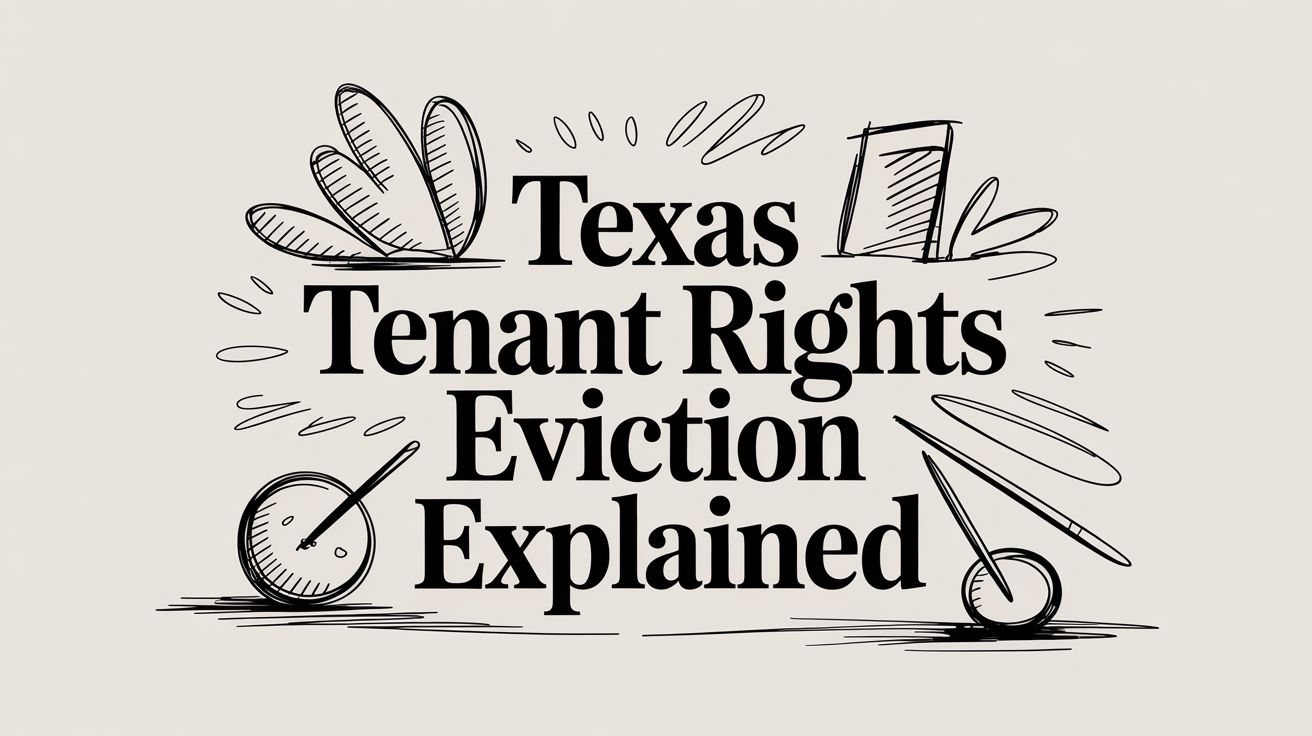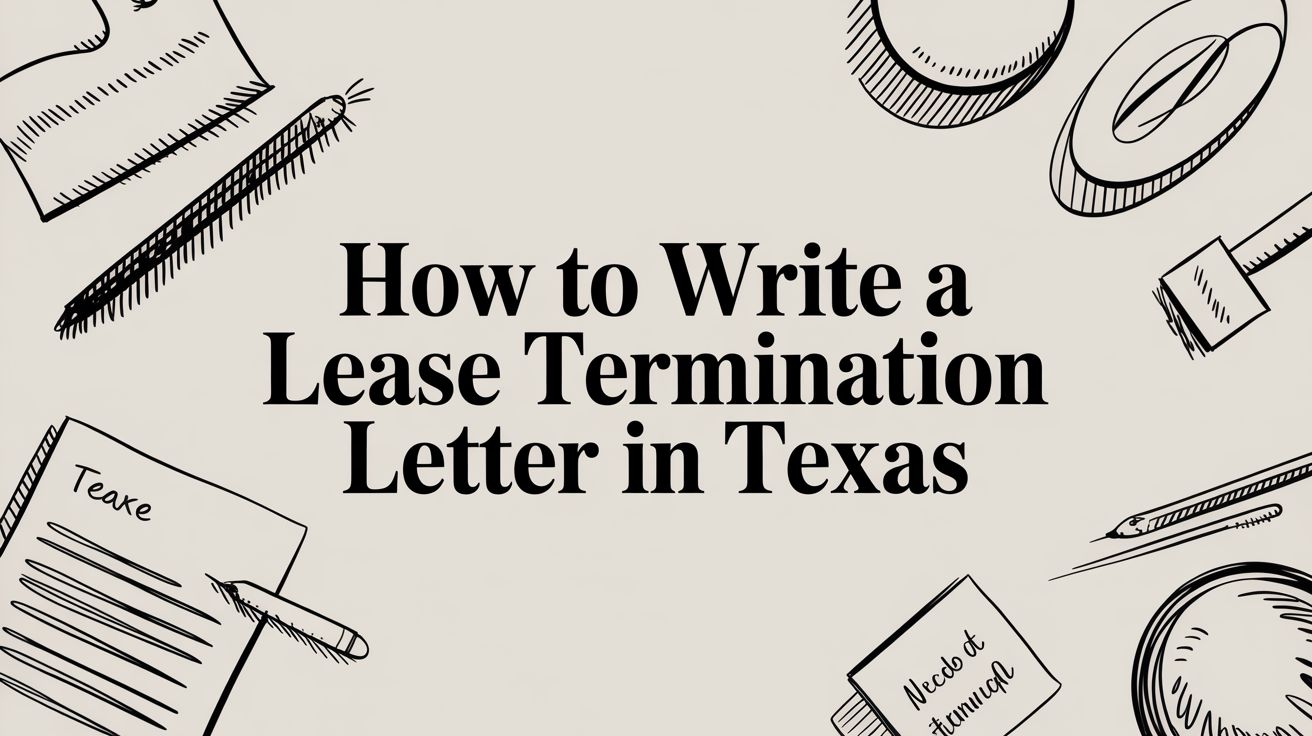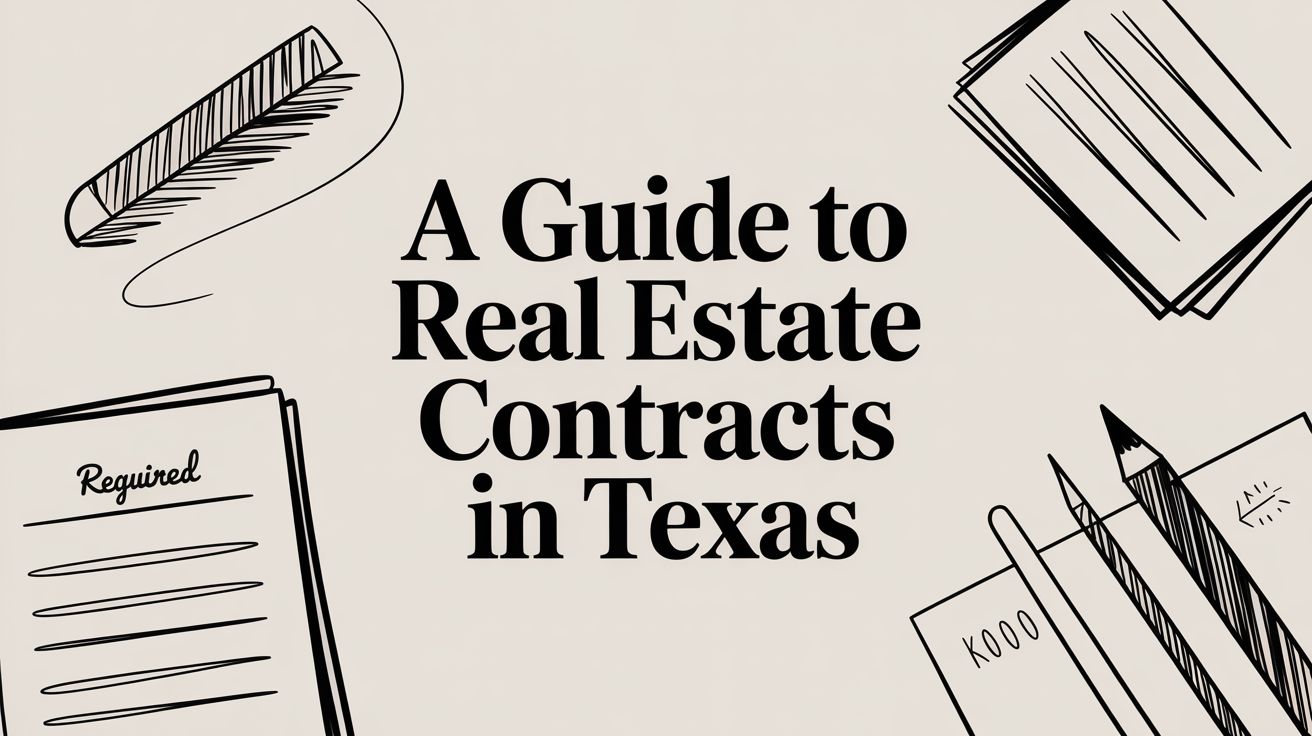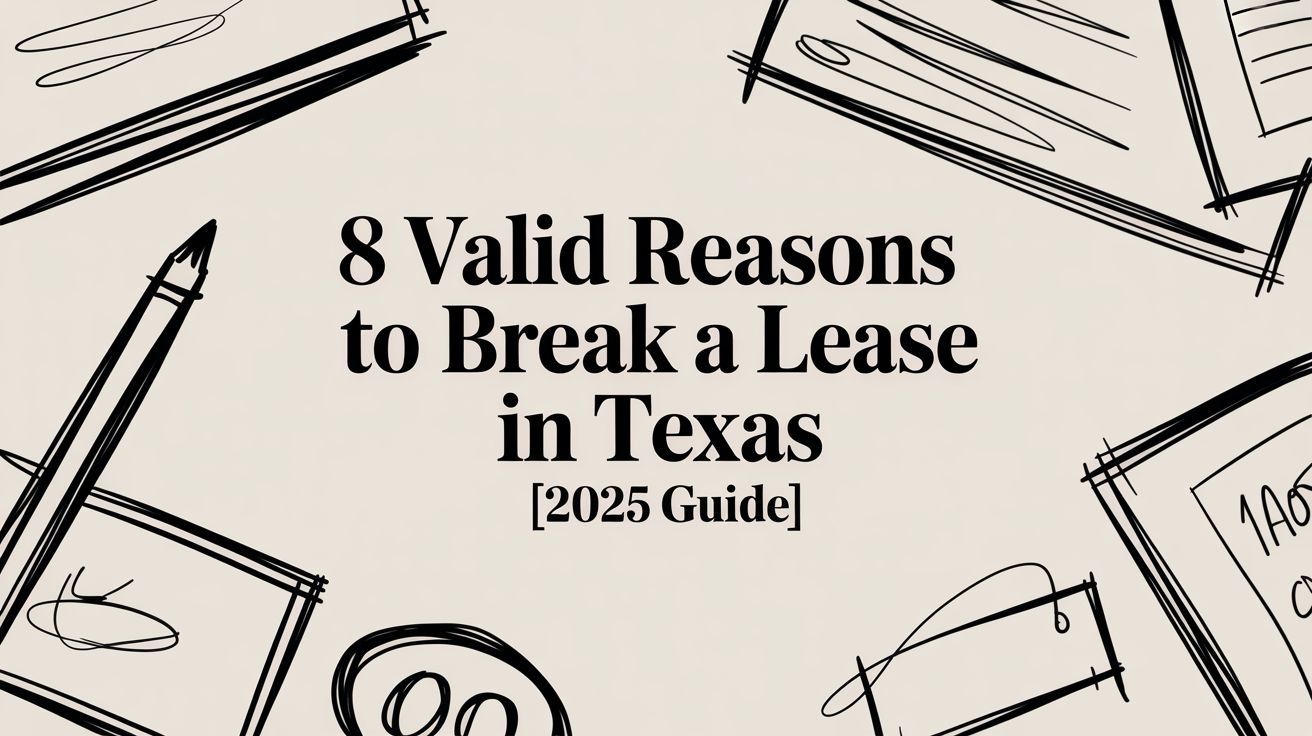Dealing with a landlord dispute, repair backlog, or security deposit disagreement can be overwhelming — but understanding your rights under the Texas Property Code and following a clear property inspection checklist for landlords can protect your investment and keep tenants safe.
In this listicle you will learn:
- Move-in, routine, and move-out inspection workflows
- Room-by-room itemized checks with photo and documentation best practices
- Key Texas Property Code sections on notice requirements (Sec. 92.056) and habitability standards (Sec. 92.052)
- Step-by-step strategies for handling repair requests, security deposit disputes, and eviction triggers
- Tips for working with a Texas landlord tenant lawyer when disputes arise
- Downloadable, printable checklist templates for on-the-go use
A thorough inspection matters because:
- Early detection of foundation cracks, water leaks, or electrical hazards cuts repair costs
- Clear documentation minimizes security deposit disputes under Texas law (Sec. 92.103)
- Compliance with Property Code timelines shields you from liability and landlord harassment claims
- Consistent checks support a safe, habitable environment that reinforces tenant rights
Throughout this article we include real-world scenarios, such as:
Discovering mold behind bathroom tiles during a routine check and coordinating licensed remediation within the 7-day repair window (Sec. 92.056)
Documenting HVAC malfunctions before summer to avoid habitability complaints and potential rent reductions
As a Texas landlord or property manager, you must follow notice timelines and repair obligations defined in the Texas Property Code. This checklist guides you through each inspection type, flags common repair triggers like roof leaks and faulty wiring, and clarifies when to issue written notices under Sec. 92.056.
By following these actionable steps, you minimize disputes over security deposits, uphold tenant rights, and strengthen your position if eviction proceedings or lease disputes arise. Ready to protect your property and maintain compliance with Texas landlord-tenant law? Keep reading for the complete property inspection checklist for landlords.
1. Structural Integrity and Foundation Assessment
A structural integrity and foundation assessment checks the property’s foundation, load-bearing walls, roof framing, and support beams for signs of damage or wear. This evaluation helps landlords spot cracks, settling issues, and water infiltration before they turn into safety hazards or costly repairs.
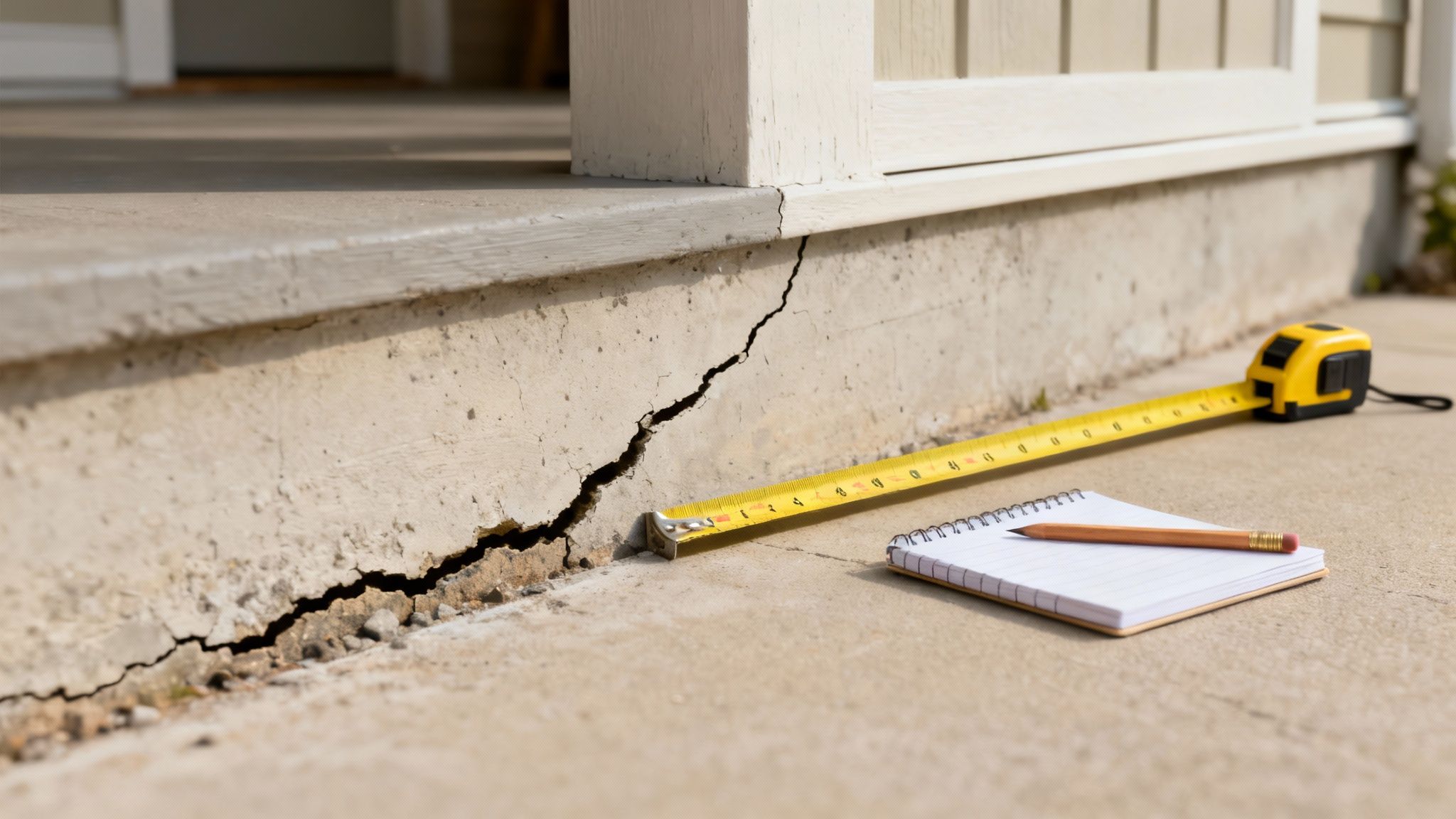
Learn more about Structural Integrity and Foundation Assessment on domain.com
What It Is
An in-depth survey performed by a licensed professional to:
- Measure settling and movement in the foundation
- Inspect load-bearing elements for cracks or rot
- Evaluate roof trusses and joists for structural soundness
Why It Matters
- Safety First: Prevent collapse risks that threaten tenant lives and landlord liability
- Cost Control: Early detection can save $10,000+ in foundation repairs
- Legal Compliance: Under Texas Property Code Sec. 92.052 landlords must maintain safe structural components
When to Use
- Before tenant move-in or lease renewal
- After severe weather events, like heavy rains or hail
- When you notice interior wall cracks or uneven floors
Actionable Tips
- Hire a licensed structural engineer for a full report
- Document all findings with dated photos and measurements
- Prioritize foundation fixes over cosmetic upgrades
- Keep written reports for insurance claims and possible legal disputes
- Schedule annual checks, especially in high-settlement zones
Real-World Examples
- A Dallas landlord spotted hairline foundation cracks during move-out inspection and saved $12,000 by sealing them before major damage occurred
- A Houston property manager uncovered loose roof trusses after heavy storms and prevented mold and drywall damage
By making structural integrity and foundation assessments a core item in your property inspection checklist for landlords you protect your investment, comply with Texas law, and provide a secure home for your tenants.
2. HVAC System Performance and Maintenance
A performance evaluation of heating, ventilation and air conditioning (HVAC) systems ensures furnaces, AC units, thermostats and ductwork all work properly to keep tenants comfortable and meet habitability standards. Regular inspections prevent breakdowns, extend equipment life and reduce energy bills.

Learn more about HVAC System Performance and Maintenance on domain.com
What It Is
An HVAC performance survey by a certified technician to:
- Test heating and cooling output across all rooms
- Inspect ductwork for leaks, blockages or mold
- Check refrigerant levels, airflow and thermostat calibration
Why It Matters
- Tenant Comfort: Stable indoor temperatures cut complaints and vacancies
- Cost Savings: Early leak detection can save $1,500–$2,000 on repairs
- Energy Efficiency: Well-tuned systems use up to 20% less electricity
- Legal Compliance: Texas Property Code Sec. 92.052 requires landlords to maintain safe and habitable HVAC
When to Use
- Before tenant move-in and at each seasonal transition
- At least once a year with a North American Technician Excellence (NATE) inspector
- Whenever tenants report uneven cooling, heating issues or utility spikes
Actionable Tips
- Schedule professional HVAC inspections annually
- Maintain detailed service records for all maintenance and repairs
- Replace air filters every 1–3 months based on usage and manufacturer guidelines
- Test both heating and cooling functions seasonally
- Include HVAC maintenance responsibilities in your lease agreement
- Consider installing programmable thermostats to control energy costs
Real-World Examples
- A San Antonio landlord discovered a small refrigerant leak in spring and avoided tenant complaints during a 100°F summer week
- Annual furnace tune-ups for a Dallas property cut emergency winter repairs by 80% and reduced tenant heating costs
By adding HVAC System Performance and Maintenance to your property inspection checklist for landlords you protect your investment, ensure habitability under Texas law and keep energy costs under control.
3. Plumbing System and Water Quality Inspection
A plumbing system and water quality inspection checks all water supply lines, drainage systems, fixtures, and overall water safety. Landlords can prevent water damage, mold growth, and health issues by ensuring code compliance and detecting issues early.

Learn more about Plumbing System and Water Quality Inspection on texastenantlawyers.com
What It Is
A hands-on assessment by a qualified plumber to:
- Verify hot and cold water pressure at each fixture
- Inspect drainage flow and clear minor blockages
- Analyze water samples for lead, bacteria and pH levels
- Check for hidden leaks under sinks, behind walls and in crawl spaces
- Confirm main shut-off valve operation and proper labeling
Why It Matters
- Safety First: Prevent scalds, contaminated water and mold exposure
- Property Preservation: Early leak detection can save $1,000+ in repairs
- Code Compliance: Texas Property Code Sec. 92.052 requires functioning water systems
- Tenant Satisfaction: Reliable plumbing boosts lease renewals and referrals
When to Use
- Before tenant move-in or lease renewal
- Annually or after extreme weather events like a hard freeze
- After tenant reports low pressure, slow drains or discoloration
- Prior to a sale, refinance or major renovation
Actionable Tips
- Test every faucet, shower and toilet for hot/cold pressure and drainage
- Inspect under sinks and behind toilets with a moisture meter
- Map and label all shut-off valves and share locations with tenants
- Check water heater thermostat settings to reduce scald risk
- Schedule periodic water quality tests in older homes
Real-World Examples
- A Houston landlord caught galvanized pipe corrosion and avoided a $4,500 burst repair
- In Austin, pre-lease testing revealed elevated lead levels, prompting safe remediation
By making plumbing system and water quality inspections a core item in your property inspection checklist for landlords you protect your investment, comply with Texas law, and provide a healthy home for your tenants.
4. Electrical System Safety and Code Compliance
An electrical system safety and code compliance inspection evaluates the property’s electrical panel, wiring, outlets, switches, and safety devices to ensure they meet National Electrical Code (NEC) standards and Texas Property Code requirements. This process helps landlords verify proper grounding, adequate amperage, and the absence of fire or shock hazards for renters.

What It Is
An inspection by a licensed electrician that includes:
- Examining breaker panels for correct labeling and load capacity
- Testing outlets and switches with a plug tester for proper voltage and grounding
- Verifying GFCI protection in bathrooms, kitchens, garages, and outdoor areas
Why It Matters
- Fire Prevention: Identifies outdated knob-and-tube or aluminum wiring that can spark fires
- Legal Compliance: Meets Texas Property Code Sec. 92.052 duty to maintain safe electrical components
- Tenant Safety: Reduces risk of shocks and power interruptions
When to Use
- Prior to tenant move-in or lease renewal
- If breakers trip frequently or lights flicker
- During annual routine inspections
Actionable Tips
- Hire a licensed electrician for a complete safety report
- Replace all two-prong outlets with grounded three-prong or GFCI units
- Document panel capacity, available circuits, and photos for your records
- Test smoke and carbon monoxide detectors monthly
- Keep dated inspection reports for insurance and legal compliance
Real-World Examples
- A San Antonio landlord discovered knob-and-tube wiring during move-out inspection and replaced it, avoiding a possible $15,000 fire restoration
- In Austin, installing GFCI outlets in an older kitchen passed a city inspection and prevented tenant shock incidents
By making electrical system checks part of your property inspection checklist for landlords, you protect tenants, comply with Texas law, and safeguard your investment. Learn more about our landlord services and your obligations under the Texas Property Code.
5. Interior and Exterior Wall Conditions
A wall condition assessment examines interior and exterior surfaces for paint deterioration, moisture intrusion, cracks, mold growth and pest entry points. This inspection helps landlords identify water damage, prevent structural decay and ensure tenant habitability under Texas law.
Learn more about Interior and Exterior Wall Inspections on BryanFaganLaw.com/landlord-responsibilities
What It Is
A detailed survey to:
- Spot peeling paint, blistering or discoloration
- Detect water stains and mold spots signaling leaks
- Locate cracks, gaps or holes that allow pests inside
- Check exterior grading and drainage around foundations
Why It Matters
- Prevent Costly Repairs: Early crack sealing and moisture barrier fixes can save $2,000+ in drywall and plaster work
- Ensure Habitability: Texas Property Code Sec. 92.052 requires landlords to maintain walls free of health hazards like mold
- Protect Property Value: Well-maintained walls boost curb appeal and support higher rental rates
When to Use
- Before move-in walkthroughs or security deposit return
- After heavy rain or roof damage reports
- During annual or biannual routine inspections
- Whenever tenants report staining, mildew or drafts
Actionable Tips
- Photograph all walls before tenant occupancy with date stamps
- Use a moisture meter on suspect spots and log readings
- Inspect crawl space and basement walls for efflorescence
- Seal cracks and gaps with appropriate filler and exterior caulk
- Apply mold-resistant primer and professional paint if needed
- Ensure exterior ground slopes away from walls at least 6 inches over 10 feet
Real-World Examples
- A San Antonio landlord detected attic wall stains during move-out, fixed flashing and stopped mold spread
- A Dallas property manager sealed minor foundation wall gaps, preventing a costly termite infestation
By making interior and exterior wall conditions a core item in your property inspection checklist for landlords, you comply with Texas habitability laws, protect your tenants and safeguard your investment.
6. Roof Condition and Weatherproofing Assessment
A roof condition and weatherproofing assessment evaluates the roof’s structure, shingles, flashing, gutters, and overall integrity to ensure it shields the property from water intrusion and weather damage. Landlords must act early—failing roofs rank among the costliest repairs and can trigger interior mold, rot, and habitability disputes under Texas law. While you can perform a basic visual review, engaging professionals offers comprehensive insights; consider consulting this homeowner’s guide to roof inspection services for best practices.
What It Is
A systematic inspection—often with binoculars or by a licensed roofer—to:
- Check shingle condition, granule loss, and curling
- Inspect flashing around chimneys, vents, and valleys
- Examine gutters and downspouts for blockages and proper slope
- Verify underlayment and sheathing integrity from the attic
Why It Matters
- Prevent Water Damage: Early leaks lead to mold, drywall decay, and structural rot
- Cost Control: Replacing a few damaged shingles costs hundreds versus thousands for a full roof
- Legal Compliance: Under Texas Property Code Sec. 92.052 landlords must provide weatherproof premises
When to Use
- Before tenant move-in or lease renewal
- After heavy storms, hail, or high winds
- During spring and fall maintenance cycles
Actionable Tips
- Inspect from ground with binoculars; wear fall protection if climbing
- Hire a certified roofer for detailed reports every 3–5 years
- Clean gutters at least twice yearly; increase frequency near trees
- Check the attic for water stains, mold, or insulation damage
- Document roof age, material, and minor repairs for insurance records
- Trim overhanging branches to reduce debris and impact damage
Real-World Examples
- A Houston landlord spotted missing shingles in spring and prevented a $5,000 water-damage claim
- A San Antonio property manager cleaned clogged gutters biannually and avoided basement flooding during heavy rains
By including roof condition and weatherproofing assessments in your property inspection checklist for landlords you protect tenant health, reduce repair costs, and meet Texas habitability standards.
7. Kitchen and Bathroom Fixture and Appliance Inspection
A kitchen and bathroom fixture and appliance inspection involves a room-by-room evaluation of sinks, faucets, toilets, showers, cabinetry, and built-in appliances. Landlords must verify that each fixture works correctly, that surfaces are clean and sealed against water intrusion, and that appliances operate safely. These high-traffic areas often harbor leaks or wear that can lead to mold, water damage, or tenant complaints.
What It Is
A systematic check covering every kitchen and bathroom component to:
- Test faucets, shower heads, and toilet flush mechanisms
- Inspect under-sink plumbing for leaks or corrosion
- Examine cabinetry and countertops for warping or mold
- Verify operation of appliances (dishwasher, range, exhaust fan)
Why It Matters
- Prevent Costly Damage: Early caulk replacement stops water seepage behind walls and under floors
- Tenant Satisfaction: Faulty fixtures or noisy appliances often trigger move-in disputes
- Legal Compliance: Under Texas Property Code Sec. 92.052 landlords must repair plumbing and maintain habitability
- Deposit Protection: Documented pre-move-in condition makes security deposit disputes easier to resolve
When to Use
- During move-in and annual routine inspections
- Before lease renewals or tenant turnover
- After power surges or major plumbing repairs
- When renters report leaks, clogs, or appliance failures
Actionable Tips
- Test every fixture for steady water flow and proper shut-off
- Look for drips or pooling at pipe joints and trap assemblies
- Remove range hood filters and replace or clean them annually
- Check grout and caulk lines around tubs, sinks, and backsplashes
- Photograph each appliance serial number and operational status
- Note any dents, rust, or loose handles in your inspection report
Real-World Examples
- A Houston landlord found deteriorated bathroom grout and prevented a mold outbreak by regrouting before tenant move-in
- A Dallas property manager tested a garage-kitchen dishwasher, discovered a failing motor, and replaced it to avoid complaints on Day One
By making kitchen and bathroom fixture and appliance inspection a core part of your property inspection checklist for landlords you protect your investment, comply with Texas law, and provide a move-in ready home your tenants will appreciate.
8. Flooring Material and Subfloor Integrity
A flooring material and subfloor integrity assessment evaluates all surface coverings—hardwood, tile, carpet—and the underlying support structures for signs of wear, moisture damage, or structural weakness. Landlords in Texas must ensure floors comply with habitability standards under Texas Property Code Sec. 92.052(b) to protect tenants from slip hazards, accessibility issues, and costly repairs down the road.
Learn more about how flooring damage can impact security deposits on domain.com
What It Is
A room-by-room inspection to:
- Check surface conditions (scratches, stains, loose tiles)
- Probe for soft spots indicating subfloor rot or water intrusion
- Use a moisture meter in basements or crawl spaces
- Assess transitions between different flooring materials for trip hazards
Why It Matters
- Tenant Safety: Prevent falls or mobility barriers for children and elderly renters
- Preserve Value: Addressing minor damage early avoids full subfloor replacement ($3,000+)
- Legal Compliance: Under Texas Property Code Sec. 92.052 landlords must maintain safe, functional living areas
When to Use
- Before tenant move-in or at lease renewal to set a damage baseline
- After plumbing leaks, HVAC overflows, or flood events
- If tenants report squeaks, bumps, or moisture odors in specific rooms
Actionable Tips
- Walk every room in shoes and socks to detect squeaks or movement
- Scan carpeting seams for buckles or high-wear patches
- Document existing flooring age and estimated remaining lifespan
- Inspect underneath via access panels or crawl spaces for mold or rot
- Replace visibly damaged or stained flooring before leasing
- Choose water-resistant, low-maintenance materials like luxury vinyl tile
Real-World Examples
- A San Antonio landlord discovered a soft spot under laminate near a bathroom and sealed a slow leak, avoiding a $5,000 subfloor replacement
- In Austin, inspection under rental-unit carpet uncovered black mold; prompt remediation protected tenant health and reduced liability
By making Flooring Material and Subfloor Integrity a core item in your property inspection checklist for landlords you uphold Texas law, protect tenant well-being, and safeguard your investment.
9. Safety Systems and Emergency Equipment Verification
Safety Systems and Emergency Equipment Verification ensures that smoke detectors, carbon monoxide alarms, fire extinguishers, emergency lighting, and escape routes are fully operational and code compliant. Adding these checks to your property inspection checklist for landlords helps you meet Texas fire and building regulations while reducing liability. Nonfunctional safety devices can lead to tenant injuries, fire code violations, and expensive legal claims under the Texas Property Code.
What It Is
A room-by-room audit of life-safety devices to:
- Test smoke and carbon monoxide detectors for proper operation
- Inspect fire extinguishers for charge level and accessible mounting
- Verify emergency lighting and exit signs work during power loss
- Check that hallways and egress paths are clear and marked
Why It Matters
- Tenant Safety: Functional alarms and exits protect tenants from fire and gas poisoning
- Legal Compliance: Texas Property Code Sec. 92.254 requires working smoke alarms at lease start and ongoing maintenance
- Liability Reduction: Regular checks can prevent lawsuits and insurance claims after an incident
When to Use
- At initial move-in and annual lease renewals
- Monthly during routine property walkthroughs
- After maintenance work, power outages, or severe weather events
Actionable Tips
- Test all detectors monthly using the built-in button
- Replace batteries twice yearly (tie to daylight saving time)
- Install alarms on every level, inside each bedroom, and outside sleeping areas
- Keep emergency numbers and evacuation maps posted in common areas
- Document every check with date-stamped photos and log entries
- Provide tenants simple operating instructions for each device
- Consider interconnected or wireless alarms for centralized alerts
- Verify that all exit routes are unobstructed and clearly marked
- For a deeper compliance strategy, consult this essential guide to fire risk assessment for landlords
Real-World Examples
- A Houston landlord’s monthly smoke detector check stopped a kitchen fire from spreading, saving the property and preventing injury
- Texas renters credit properly maintained carbon monoxide alarms for alerting them to a hidden furnace leak before it became deadly
Including safety system verification in your property inspection checklist for landlords protects lives, limits liability, and ensures you comply with Texas law.
10. Pest Infestation and Environmental Hazard Screening
A Pest Infestation and Environmental Hazard Screening checks for rodents, insects, termites, asbestos, lead paint, mold, and radon. Early detection and disclosure help landlords comply with Texas law and protect tenant health before small issues become costly or dangerous.
Learn more about Pest Infestation and Environmental Hazard Screening on domain.com
What It Is
A detailed inspection by a certified professional to:
- Identify rodent droppings, entry holes, chewed wires, and insect nests
- Test for lead paint in pre-1978 structures under federal and state disclosure rules
- Assess mold growth in damp areas and measure radon levels where required
Why It Matters
- Health Protection: Prevent respiratory issues, allergies, and long-term illnesses
- Cost Savings: Early pest or mold remediation can save thousands in repairs
- Legal Compliance: Texas habitability standards and federal lead paint disclosure laws must be met to avoid fines and liability
When to Use
- Before tenant move-in or lease renewal
- After water leaks, flooding, or storm damage
- When neighbors report infestations or you notice musty odors
Actionable Tips
- Hire an NPMA-certified pest inspector for a full report
- Inspect attics, basements, crawl spaces, and utility chases
- Look under sinks, behind appliances, and along baseboards for signs of pests
- Order professional lead paint testing in older buildings
- Use moisture meters and thermal imaging to locate hidden mold
- Consider a short-term radon test kit in high-risk counties
- Document findings with dated photos and bind reports for lease records
- Provide tenants with a written hazard disclosure form
Real-World Examples
- A San Antonio landlord found mouse droppings in the attic and scheduled quarterly baiting, preventing a full-scale infestation
- In Austin a rental unit’s bathroom mold was remediated within 48 hours, avoiding a tenant health claim
- A Houston landlord disclosed lead paint and reduced deposit disputes by signing informed consent forms
By adding Pest Infestation and Environmental Hazard Screening to your property inspection checklist for landlords, you protect your investment, comply with Texas Property Code requirements, and ensure a safe home for your tenants.
10-Point Landlord Property Inspection Comparison
| Inspection | Complexity 🔄 | Resources & Cost ⚡ | Expected Outcomes ⭐📊 | Ideal Use Cases 💡 | Key Advantages ⭐ |
|---|---|---|---|---|---|
| Structural Integrity and Foundation Assessment | 🔄🔄🔄 High | Licensed structural engineer or home inspector; $300–$500; several hours | ⭐ High safety certainty; 📊 prevents major structural failures and costly repairs | 💡 Pre-purchase, pre-occupancy, after visible settling or seismic events | ⭐ Reduces liability; early detection of major issues; preserves asset value |
| HVAC System Performance and Maintenance | 🔄🔄 Moderate | HVAC technician; $150–$300; annual/seasonal checks; filter upkeep | ⭐ Ensures comfort and habitability; 📊 reduces energy use and emergency repairs | 💡 Move-in checks, seasonal tune-ups, efficiency upgrades | ⭐ Improves comfort; lowers energy bills; extends equipment life |
| Plumbing System and Water Quality Inspection | 🔄🔄🔄 Moderate–High | Licensed plumber; $200–$400 (+ $150–$300 for water tests); leak detection tools | ⭐ Prevents water damage and health risks; 📊 reduces mold and long-term repair costs | 💡 Older buildings, after leaks, pre-occupancy or resale | ⭐ Protects structure; documents code compliance; reduces tenant complaints |
| Electrical System Safety and Code Compliance | 🔄🔄🔄 High | Licensed electrician; $200–$500 inspection (rewiring $3,000+ if needed) | ⭐ Ensures electrical safety; 📊 lowers fire/shock risk and liability | 💡 Older wiring, appliance upgrades, pre-occupancy code checks | ⭐ Major safety improvements; insurance and code compliance |
| Interior and Exterior Wall Conditions | 🔄🔄 Moderate | Home inspector/contractor; cosmetic $500–$3,000; mold remediation $2,000+ if found | ⭐ Detects moisture, mold, and pest entry early; 📊 prevents value loss and repairs | 💡 Pre-lease documentation, after storms/leaks, visible stains/cracks | ⭐ Early moisture detection; aids dispute documentation; pest prevention |
| Roof Condition and Weatherproofing Assessment | 🔄🔄 Moderate | Roofer/inspector; $150–$300 inspection; repairs $500–$5,000+; replacement $5,000+ | ⭐ Prevents leaks and interior damage; 📊 extends roof life and insurability | 💡 Pre-winter/spring checks, pre-sale, after storm events | ⭐ Protects building envelope; reduces costly interior repairs |
| Kitchen and Bathroom Fixture and Appliance Inspection | 🔄🔄 Low–Moderate | Home inspector or handyman; low–moderate cost; quick functional tests | ⭐ High tenant satisfaction impact; 📊 reduces move-in complaints and small failures | 💡 Turnover inspections, move-in readiness, post-maintenance checks | ⭐ Reduces disputes; prevents water damage from fixtures; improves tenant experience |
| Flooring Material and Subfloor Integrity | 🔄🔄 Moderate | Inspector/contractor; repairs/refinish $1–10+/sq ft; moisture meter use | ⭐ Ensures floor safety; 📊 detects water damage and mold risk early | 💡 After plumbing incidents, before tenancy, older floors showing wear | ⭐ Prevents trip/fall hazards; informs replacement planning |
| Safety Systems and Emergency Equipment Verification | 🔄 Low | Basic checks and batteries; $50–$200/yr for battery replacements; upgrades $500+ | ⭐ Ensures life-safety compliance; 📊 greatly reduces liability and legal risk | 💡 Monthly checks, pre-occupancy, code-required inspections | ⭐ Critical life-safety assurance; required for insurance/code compliance |
| Pest Infestation and Environmental Hazard Screening | 🔄🔄🔄 Moderate–High | Pest inspector and specialized testing (lead/asbestos/mold/radon); $100–$600+; remediation costly | ⭐ Identifies health hazards and infestations; 📊 prevents spread and legal exposure | 💡 Pre-1978 properties, signs of pests, health-sensitive tenants, pre-occupancy | ⭐ Protects tenant health; enables required disclosures; prevents large infestations |
Next Steps to Secure Your Rental Property
You’ve tackled each element of the property inspection checklist for landlords — from foundation cracks to pest screening. Now it’s time to turn insights into action. Following these steps will help you stay Texas-compliant, protect your investment, and reduce the risk of disputes.
Key Takeaways
- Structural integrity and foundation checks safeguard against major repairs later
- HVAC, plumbing, and electrical inspections keep tenants safe and comfortable
- Consistent photo and document logs create an audit trail under Texas Property Code Sec. 92.103
- Room-by-room reviews highlight wear patterns and necessary upgrades
- Notice requirements (Sec. 92.0081) ensure you give proper warning before entry
- Move-out inspections tied directly to security deposit deductions
- Detailed templates and printable checklists save time and standardize inspections
Regular documentation and timely repairs are your best legal defense in security deposit disputes and eviction challenges.
Actionable Next Steps
-
Schedule Quarterly or Biannual Inspections
- Use your printable checklist to cover all 10 key areas
- Send written notice at least 24 hours in advance (Texas Property Code Sec. 92.0081)
- Photograph preexisting issues to avoid future disputes
-
Create a Centralized Inspection Binder
- Store digital and paper copies of all reports
- Include tenant acknowledgment signatures
- Link to repair invoices and contractor communications
-
Implement a Photo-First Documentation Policy
- Capture clear time-stamped images of damages
- Annotate images with notes (location, likely cause, recommended repair)
- Archive photos by inspection date for quick retrieval
-
Handle Repair Requests Step-by-Step
- Require tenants to submit repair requests in writing under Sec. 92.056
- Acknowledge receipt immediately and schedule licensed contractors
- Complete repairs within 7 days to avoid tenant rent abatement or claims
- Keep invoices and before/after photos in your inspection binder
-
Process Security Deposit Returns and Disputes
- Within 30 days of lease termination, return deposits or send an itemized statement (Sec. 92.103)
- Document tenant-caused damages with photos, repair invoices, and inspection reports
- Offer clear communication and consider mediation before legal action
-
Initiate Eviction Proceedings Correctly
- For non-payment of rent, deliver a 3-day Notice to Vacate under Section 24.005 of the Texas Property Code
- File your eviction petition with the justice court if the tenant does not comply
- Consult a Texas landlord tenant lawyer or eviction attorney to draft notices and represent you
-
Finalize Move-Out Assessments Promptly
- Conduct walkthrough within 7 days of lease termination
- Compare move-in and move-out checklists side by side
- Deduct only documented, tenant-caused damages from the security deposit
Why This Matters
Securing your rental property with a rigorous inspection routine:
- Minimizes repair costs by catching issues early
- Builds tenant trust through transparency and clear communication
- Reduces legal risk tied to habitability, deposit disputes, and wrongful entry claims
- Preserves or increases long-term property value
Mastering these steps gives you confidence that every inspection is thorough, compliant, and defensible if ever challenged in court.
As you integrate this checklist into your property management process, remember that consistency is key. A well-executed inspection program not only protects you under the Texas Property Code but also enhances the tenant experience — leading to longer leases and fewer vacancy periods. Stay proactive, stay compliant, and keep your rental investment secure.
If you need help with an eviction, lease issue, or rental dispute, schedule your free consultation with The Law Office of Bryan Fagan, PLLC at The Law Office of Bryan Fagan, PLLC today. Our experienced Texas landlord tenant lawyer team will protect your rights and guide you through every step.

